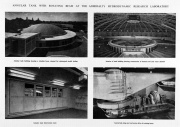Difference between revisions of "Admiralty Hydrodynamic Research Laboratory"
| Line 1: | Line 1: | ||
[[image:Im1955v200-p792.jpg|thumb| 1955.]] | [[image:Im1955v200-p792.jpg|thumb| 1955.]] | ||
1954 A new Hydrodynamic Laboratory was completed at the end of 1954 at the [[Admiralty Research Laboratory]], Teddington, London. | 1954 A new Hydrodynamic Laboratory was completed at the end of 1954 at the [[Admiralty Research Laboratory]], Teddington, London. The new laboratory housed some items of equipment which were unique in design, most spectacular of which is a 60-ton beam, which has an overall span of 122 feet. This rotates in an annular channel and is designed to investigate the behaviour of bodies moving at speed under water. It was built under a dome of 156 feet in diameter - larger than the dome of either St. Pauls, London or St. Peters, Rome. | ||
Two water tunnels, similar in principle to the wind tunnels used in aerodynamic research, were built for for testing models; the 30-foot water tunnel was powered by a 100 horsepower motor. | Two water tunnels, similar in principle to the wind tunnels used in aerodynamic research, were built for for testing models; the 30-foot water tunnel was powered by a 100 horsepower motor. | ||
Revision as of 18:45, 26 December 2018
1954 A new Hydrodynamic Laboratory was completed at the end of 1954 at the Admiralty Research Laboratory, Teddington, London. The new laboratory housed some items of equipment which were unique in design, most spectacular of which is a 60-ton beam, which has an overall span of 122 feet. This rotates in an annular channel and is designed to investigate the behaviour of bodies moving at speed under water. It was built under a dome of 156 feet in diameter - larger than the dome of either St. Pauls, London or St. Peters, Rome.
Two water tunnels, similar in principle to the wind tunnels used in aerodynamic research, were built for for testing models; the 30-foot water tunnel was powered by a 100 horsepower motor.
A glass-sided tank was built for investigating the problem of the entry of missiles from the air into water. Missile were fired at various angles by a catapult operated by compressed air at speeds up to 180 knots, corresponding to about 570 knots at full scale.
See Also
Sources of Information
- [1] IWM


